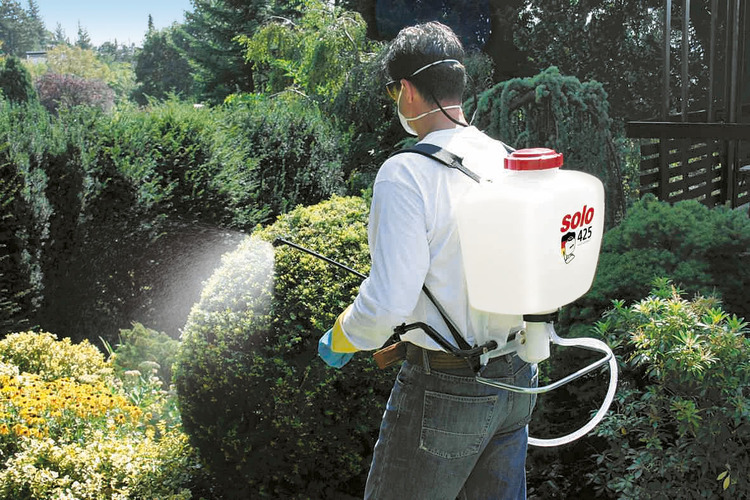
by Daniel J. Leonard | Jun 24, 2021
Nutsedge, commonly called “nutgrass”, is one of the most important and difficult to control weed pests in the world. Found in nearly every growing situation, from crop fields and vegetable gardens to landscapes and turfgrass lawns, I bet every person reading this has contended with controlling nutsedge at some point! Nutsedge (a common term to describe several species of weeds in the genus Cyperus) not only reduces curb appeal, but also h as a detrimental effect on desirable plantings around it. Because of its aggressive nature and dense root system, it competes heavily with “good” plants for water, light, and nutrients, causing the plants we are trying to grow to suffer. This is a weed that you definitely do not want in your lawn or landscape!
To keep nutsedge at bay, it’s important to know a few facts about it. First, “nutgrass” is not a grass at all, but a totally different class of plants known as sedges. This is important because selective herbicides used to kill grassy weeds will not affect nutsedge. Though they’re grass look-alikes, sedges can be distinguished by their distinctive triangular shaped stems. You can actually feel the three edges of nutsedge stems. If ever in doubt over whether a weed is a grass or a sedge, remember “sedges have edges”. Most sedges are perennials, dying back to the ground each year in winter and reemerging from tubers, called “nutlets”, that can survive over a foot under the ground! Also, while sedges generally prefer wet areas, they aren’t very particular about where they grow and are equally at home in sand or clay, wet or dry, and sun or shade. All these characteristics make sedges hard to control and cause much consternation amongst gardeners!
The first line of defense in controlling nutsedge is keeping a dense cover over any bare ground. In lawns, this means maintaining a thick, healthy turf as weeds love to enter lawns through thin or patchy areas. This can be accomplished by mowing regularly, fertilizing appropriately based on a soil test, not overirrigating while also not allowing the grass to suffer badly during droughty periods. Easier said than done. In landscape beds, preventative control is a little easier. First, as nutsedge prefers wet areas, only irrigate when it is needed. During much of the year, most established landscapes can get by on rainfall alone. Next, simply maintain a roughly 3” layer of pine straw, wood chips, pine bark, or other natural mulch of your choice. Doing so will reduce all manner of weeds, nutsedge included, and is generally beneficial for ornamental plants as well! I do not recommend landscape fabric as it is a pain to install and remove and is not extremely effective at reducing nutsedge as the sedge’s sharp growing points punch right through most plastic or fabric mulches.
Though mulching and other preventative measures can reduce nutsedge numbers, those methods alone are usually not enough and chemical herbicides are required. Fortunately, in Panhandle lawns and landscapes, there are several excellent, readily available options for sedge control: imazaquin and halosulfuron.
- Imazaquin is the active ingredient in the common product Image Kills Nutsedge and has good activity on most sedge species. It can be applied safely to all the common turfgrass species grown in the area and can even be sprayed right over the top of most common ornamental landscape plants!
- Halosulfuron is the active ingredient in the product Sedgehammer (available online or at specialty landscape supply stores) and several other generic products. Halosulfuron products provide excellent control of all nutsedge species and are safe to use in all turfgrass species found in Florida. While most landscape plants are tolerant of halosulfuron application, use care and try to only spray it on sedge weeds to avoid any unwanted yellowing or damage.
While both products begin working immediately, it may take several weeks to see sedge weeds start suffering and patience is necessary! Though both products are effective, follow up applications 3-4 weeks later are generally necessary to clean up any surviving sedge.
Nutsedge is a nasty little weed that can be difficult, though not impossible to manage. Through some smart cultural practices and timely applications of either imazaquin or halosulfuron, you can keep your lawn and landscapes nutsedge free! For more information about nutsedge control on your property or any other agricultural or horticultural topic, contact your local UF/IFAS County Extension office! Happy Gardening!
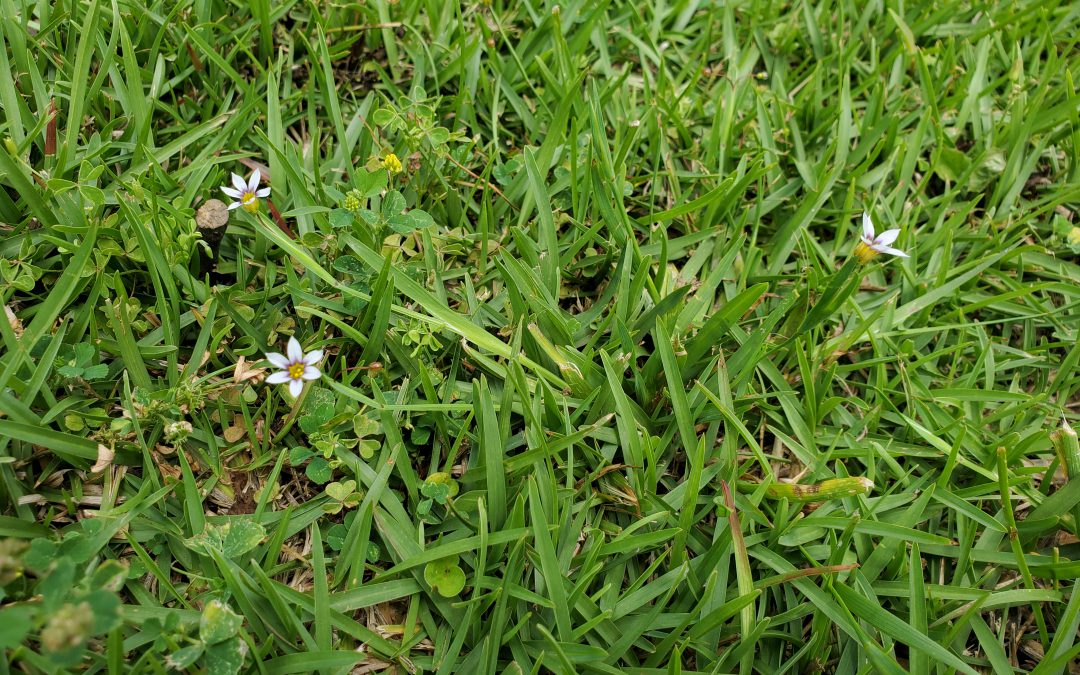
by Daniel J. Leonard | Apr 8, 2021
The line separating what is a weed and what isn’t often comes down to where the “weed” is growing and who is managing the area it’s growing in. Blue Eyed Grass (Sisyrinchium rosulatum), one of the most complained about lawn weeds this winter/spring falls squarely in that category! Native plant enthusiasts and homeowners looking to add native wildflowers to their landscape value the plant for its low maintenance, star-shaped blue blossoms in spring. Professional and home turfgrass managers, however, loathe the plant as it masquerades as grass to the untrained eye, looks messy in the cool months, and can displace turf during spring green up. While Blue Eyed Grass can be a pretty landscape plant, our focus today is on learning why it is such an annoying weed in turfgrass areas and exploring control options if it becomes a problem!
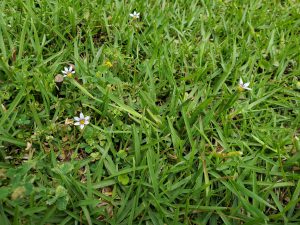
Blue Eyed Grass (Sisyrinchium rosulatum) in a Centipedegrass lawn in late March. Photo courtesy of Daniel Leonard.
For starters, Blue Eyed Grass (BEG) is not even a grass, though it does look an awful lot like one! It is actually a member of the Iris family and is more closely related to spring beauties like Gladiolus, Iris, and Crocus than any turfgrasses. The flowers, appearing late March through April, are a dead giveaway that we aren’t dealing with a grass, as are the flat leaves arranged in bunched fan-shaped rosettes. BEG is considered a winter annual plant in Florida, meaning it sprouts from seed in the fall, grows through the winter, then flowers and sets seed in the spring. Because it grows while lawn grass is dormant, it is very noticeable during its entire lifespan. Though BEG can tolerate a range of soil types, it prefers to grow in moist areas, making it right at home in Panhandle lawns and landscapes in the winter as we experience regular to excessive rainfall throughout our cool season.
All the above characteristics make BEG an annoying weed in lawns. It hides in turfgrass very well until the turf goes dormant in the dead of winter, leading most homeowners to ignore it until it becomes a problem in the spring. At this point, BEG is nearing maturity and is more difficult to control without damaging the turfgrass. BEG also thrives in our climate and can outcompete poorly managed turfgrass, especially if the lawn exhibits the soggy, compacted conditions that heavy lawn foot traffic and winter/spring rainfall cause. So, what is a homeowner to do?
The first step in controlling BEG is maintaining a healthy turf. Ensure you’re treating your turf well during the growing season by fertilizing appropriately, mowing frequently at the correct height, and irrigating properly. Sending turf into the dormant season stressed by poor growing season management is an invitation to winter weeds. Other cultural practices that can help mitigate troublesome winter weeds like BEG are periodic mowing during the cool season to prevent weeds from going to seed and being diligent about not frequently driving on, parking cars on, or otherwise excessively compacting the soil, a common cause of unhealthy turfgrass.
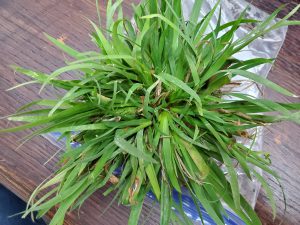
Blue Eyed Grass clump brought into the Calhoun County Extension office for identification and control recommendations in February 2021. Photo courtesy of Daniel Leonard.
After implementing the above cultural practices in your lawn management regime, you may also need chemical herbicides to achieve a clean cool season lawn. There are two basic options for BEG control. First, a fall (mid-late October) application of a pre-emergent herbicide like dithiopyr, prodiamine, or pendimethalin can be very effective at preventing winter weeds from occurring at all. If you happen to miss this fall pre-emergent application, a timely post-emergent application of 2,4-D or other general broadleaf herbicides works nicely as well. (BEG and other cool season weeds are best controlled with post-emergent herbicides in December and January before they mature and begin to set seed. Plan applications accordingly!)
While Blue Eyed Grass can be an attractive addition to the landscape, it is never welcome in turfgrass! To prevent this and weeds from becoming a problem, use smart cultural practices to maintain a healthy turf and make timely herbicide applications when needed. For more information on controlling Blue Eyed Grass and other winter weeds, contact your local UF/IFAS Extension office!
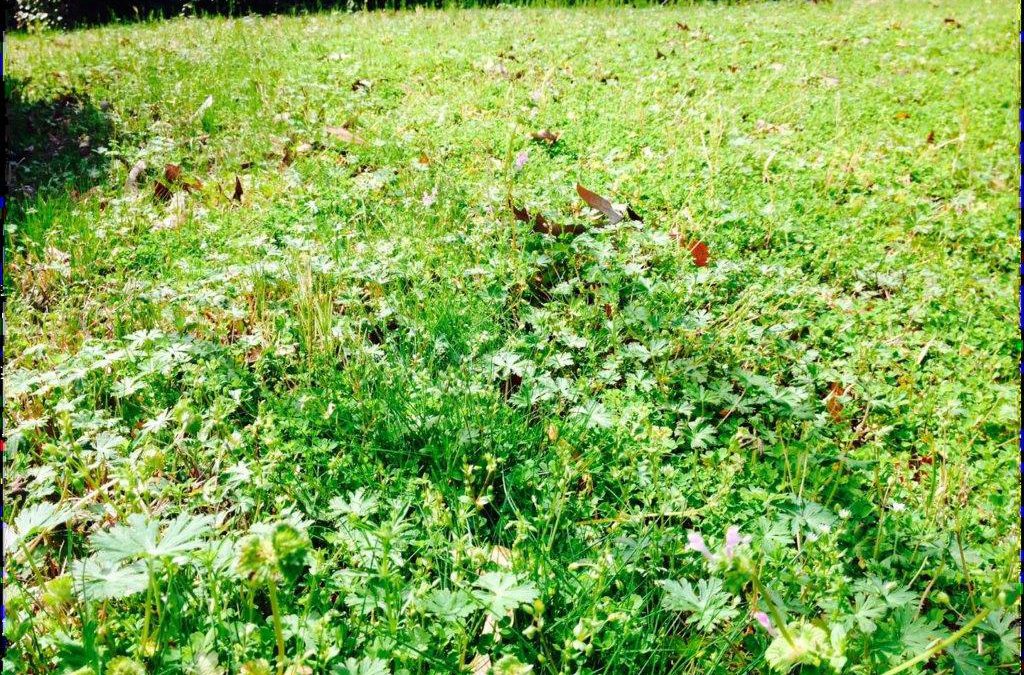
by Mark Tancig | Feb 11, 2021
Gardeners worldwide and throughout time have bemoaned weeds. In Florida, we get to enjoy weeds all year long! Our February Gardening in the Panhandle (GIP) Live episode focused on weeds and weed control. Many homeowners are interested in ways to control weeds and UF/IFAS Extension and your local extension agents are here to help. The following is a summary of the topics we discussed and links for more research-based information on weeds.
What is a Weed?
Many folks come to the extension office holding a plant and ask, “Is this a weed”? Well, whether it is a weed or not is up to the individual, as the only definition for a weed is “a plant out of place”. Bermudagrass and Oxalis are good examples of plants that some try to grow while others try to kill. One person’s weed is another’s wildflower! However, to be clear, plants classified as invasive by UF/IFAS and governmental entities are officially weeds. There are resources to help identify several common plants that are generally considered weeds by most homeowners and landscapers.
Weed ID Links

Common, and aggravating, weeds.
How to Prevent Weeds?
There are some general gardening practices that can help prevent weeds so there is less of a need to control them. A lawn that is healthy is less likely to be invaded by weeds and the use of mulch can greatly reduce weed growth in planting beds. Other practices, like the placement of weed fabrics/cloths are less effective and/or less practical in many garden situations.
Weed Prevention Links
How to Control Weeds?
Once you know and/or decide that what you have is a weed and that it needs to be dealt with, then you have to consider your control options. Prevention, as mentioned above, is key but sometimes you may need to use other methods of control, such as physical, mechanical, and/or chemical means. With chemical weed control, it is important to always read and follow the product label.
Weed Control Links
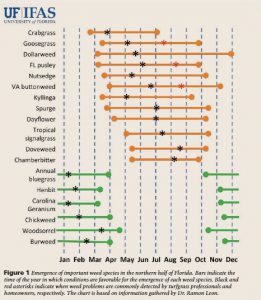
General dates of common annual weed emergence. Credit: Dr. Ramon Leon, UF/IFAS.
Specific Weed Recommendations
When managing pests, proper identification is key to effective control. Because some weeds are annuals, and present either during the cool or warm season, and others are perennials, proper weed identification can provide a more detailed control strategy. Use the weed ID links above and the document links below for more precise, and effective, weed management.
Species-Specific Control Links
If you need additional assistance with weed control, please contact your local county extension office. Please tune in for future GIP LIVE episodes for more research-based information on gardening topics.
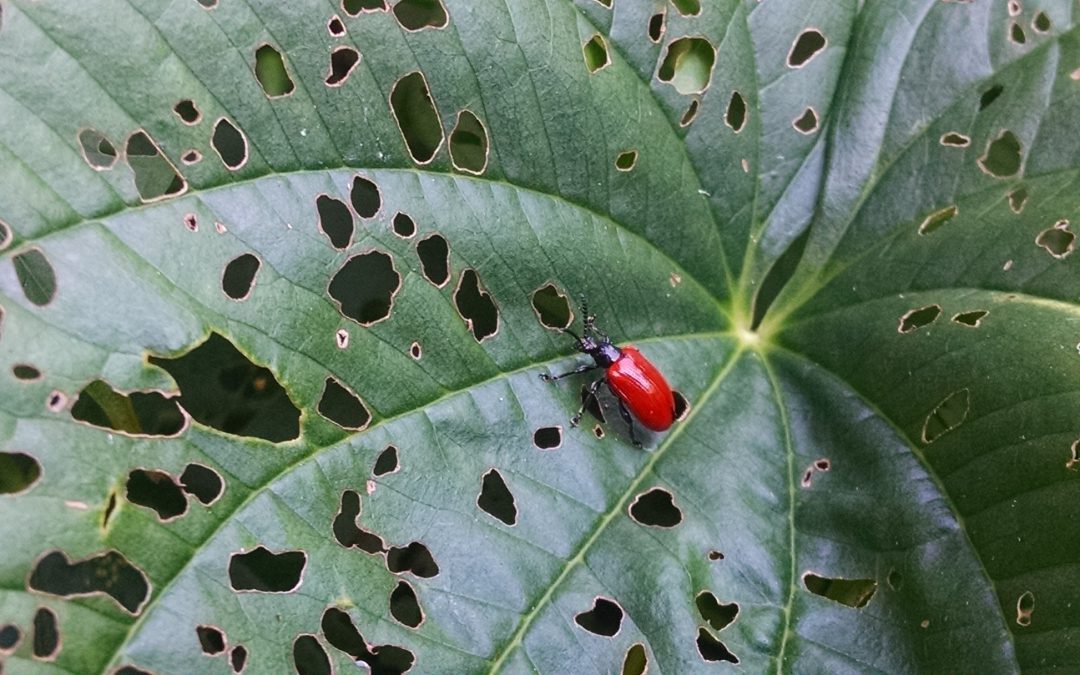
by Daniel J. Leonard | Oct 14, 2020
Article by Jessica Griesheimer & Dr. Xavier Martini, UF/IFAS North Florida Research and Education Center, Quincy
Dioscorea bulbifera, commonly known as the air potato is an invasive species plaguing the southeastern United States. The air potato is a vine plant that grows upward by clinging to other native plants and trees. It propagates with underground tubers and aerial bulbils which fall to the ground and grow a new plant. The aerial bulbils can be spread by moving the plant, causing the bulbils to drop to the ground and tubers can be spread by moving soil where an air potato plant grew prior. The air potato is commonly confused with and mistaken as being Dioscorea alata, the winged yam which is also highly invasive. The plants look very similar at first glance but have subtle differences. Both plants exhibit a “heart”-shaped leaf connected to vines. The vines of the winged yam have easily felt ridges, while the air potato vines are smooth. They also differ in their aerial bulbil shapes, the winged yam has a long, cylinder-shaped bulbil while the air potato aerial bulbil has a rounded, “potato” shape (Fig. 1).
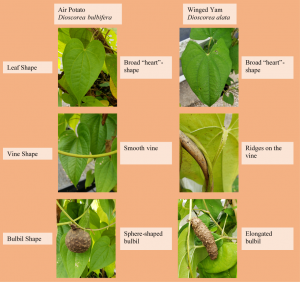
In its native range of Asia and Africa, the air potato has a local biocontrol agent, Lilioceris cheni commonly known as the Chinese air potato beetle (Fig. 2). As an adult, this beetle feeds on older leaves and deposits eggs on younger leaves for the larvae to later feed on. Once the larvae have grown and fed, they drop the ground where they pupate to later emerge as adults, continuing the cycle. The Chinese air potato beetle will not feed on the winged yam, as it is not its host plant.Current methods of air potato plant, bulbil, and tuber removal can be expensive and hard to maintain. The plant is typically sprayed with herbicide or is pulled from the ground, the aerial bulbils are picked from the plant before they drop, and the underground tubers are dug up. The herbicides can disrupt native vegetation, allowing for the air potato to spread further should it survive. If the underground tuber or aerial bulbils are not completely removed, the plant will grow back.
The Chinese air potato beetle is currently being evaluated as a potential integrated pest management (IPM) organism to help mitigate the invasive air potato. The beetle feeds and reproduces solely on the air potato plant, making it a great IPM organism choice. During 2019, we studied the Chinese air potato beetle and its ability to find the air potato plant. It was found the beetles may be using olfactory cues to find the host plant. Further research is conducted at the NFREC to increase natural aggregation of the beetles on air potato to improve biological control of the weed.
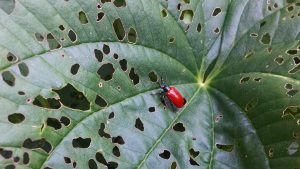
Chinese Air Potato Leaf Beetle.
If you have the air potato plant, or suspect you have the air potato plant, contact your local UF/IFAS Extension Agents for help!
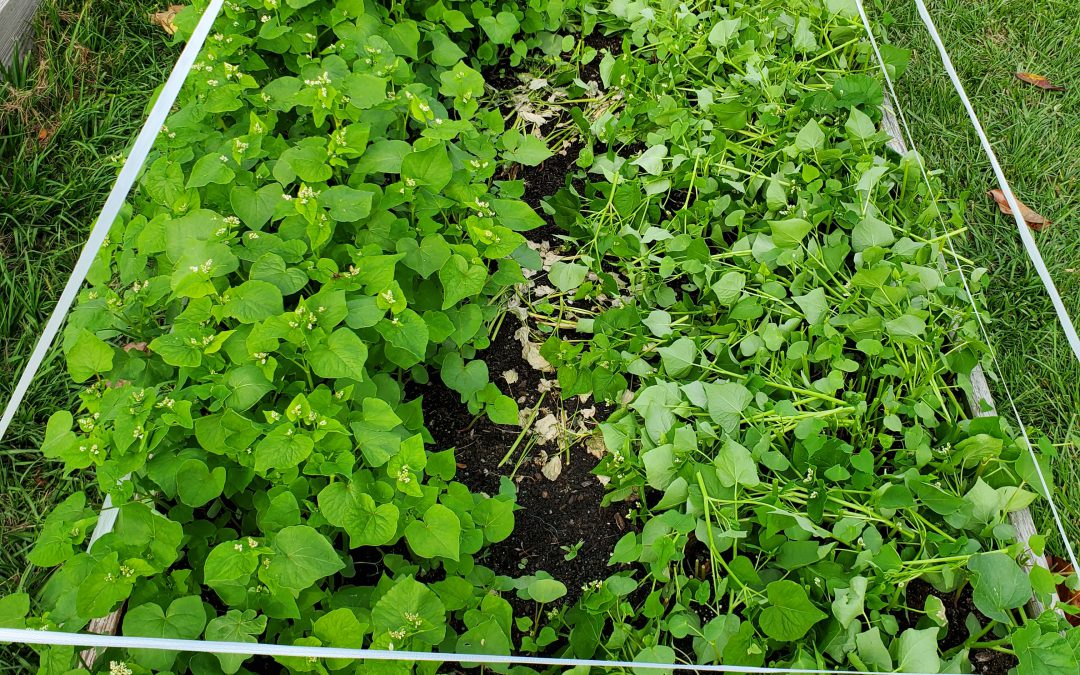
by Daniel J. Leonard | Sep 28, 2020
2020 has not been the most pleasant year in many ways. However, one positive experience I’ve had in my raised bed vegetable garden has been the use of a cover crop, Buckwheat (Fagopyrum esculentum)! Use of cover crops, a catch-all term for many species of plants used to “cover” field soil during fallow periods, became popular in agriculture over the last century as a method to protect and build soil in response to the massive wind erosion and cropland degradation event of the 1930s, the Dust Bowl. While wind erosion isn’t a big issue in raised bed gardens, cover crops, like Buckwheat, offer many other services to gardeners:
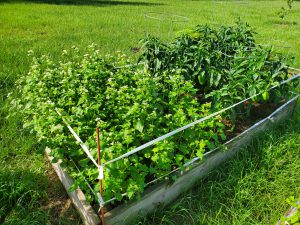
Buckwheat in flower behind summer squash. Photo courtesy of Daniel Leonard.
- Covers, like Buckwheat, provide valuable weed control by shading out the competition. Even after termination (the cutting down or otherwise killing of the cover crop plants and letting them decompose back into the soil as a mulch), Buckwheat continues to keep weeds away, like pinestraw in your landscape.
- Cover crops also build soil. This summer, I noticed that my raised beds didn’t “sink” as much as normal. In fact, I actually gained a little nutrient-rich organic matter! By having the Buckwheat shade the soil and then compost back into it, I mostly avoided the phenomena that causes soils high in organic matter, particularly ones exposed to the sun, to disappear over time due to breakdown by microorganisms.
- Many cover crops are awesome attractors of pollinators and beneficial insects. At any given time while my Buckwheat cover was flowering, I could spot several wasp species, various bees, flies, moths, true bugs, and even a butterfly or two hovering around the tiny white flowers sipping nectar.
- Covers are a lot prettier than bare soil and weeds! Where I would normally just have either exposed black compost or a healthy weed population to gaze upon, Buckwheat provided a quick bright green color blast that then became covered with non-stop white flowers. I’ll take that over bare soil any day.
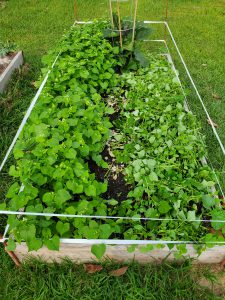
Buckwheat cover before termination (left) and after (right) interplanted with Eggplant. Photo courtesy Daniel Leonard, UF/IFAS Calhoun County Extension.
Now that I’ve convinced you of Buckwheat’s raised bed cover crop merits, let’s talk technical and learn how and when to grow it. Buckwheat seed is easily found and can be bought in nearly any quantity. I bought a one-pound bag online from Johnny’s Selected Seeds for my raised beds, but you can also purchase larger sizes up to 50 lb bags if you have a large area to cover. Buckwheat seed germinates quickly as soon as nights are warmer than 50 degrees F and can be cropped continuously until frost strikes in the fall. A general seeding rate of 2 or 3 lbs/1000 square feet (enough to cover about thirty 4’x8’ raised beds, it goes a long way!) will generate a thick cover. Simply extrapolate this out to 50-80 lbs/acre for larger garden sites. I scattered seeds over the top of my beds at the above rate and covered lightly with garden soil and obtained good results. Unlike other cover crops (I’m looking at you Crimson Clover) Buckwheat is very tolerant of imperfect planting depths. If you plant a little deep, it will generally still come up. A bonus, no additional fertilizer is required to grow a Buckwheat cover in the garden, the leftover nutrients from the previous vegetable crop will normally be sufficient!

Buckwheat “mulch” after termination. Photo courtesy of Daniel Leonard, UF/IFAS Calhoun County Extension.
Past the usual cover crop benefits, the thing that makes Buckwheat stand out among its peers as a garden cover is its extremely rapid growth and short life span. From seed sowing to termination, a Buckwheat cover is only in the garden for 4-8 weeks, depending on what you want to use it for. After four weeks, you’ll have a quick, thick cover and subsequent mulch once terminated. After eight weeks or so, you’ll realize the plant’s full flowering and beneficial/pollinator insect attracting potential. This lends great flexibility as to when it can be planted. Have your winter greens quit on you but you’re not quite ready to set out tomatoes? Plant a quick Buckwheat cover! Yellow squash wilting in the heat of summer but it’s not quite time yet for the fall garden? Plant a Buckwheat cover and tend it the rest of the summer! Followed spacing guidelines and only planted three Eggplant transplants in a 4’x8’ raised bed and have lots of open space for weeds to grow until the Eggplant fills in? Plant a Buckwheat cover and terminate before it begins to compete with the Eggplant!
If a soil building, weed suppressing, beneficial insect attracting, gorgeous cover crop for those fallow garden spots sounds like something you might like, plant a little Buckwheat! For more information on Buckwheat, cover crops, or any other gardening topic, contact your local UF/IFAS County Extension Office. Happy Gardening!














